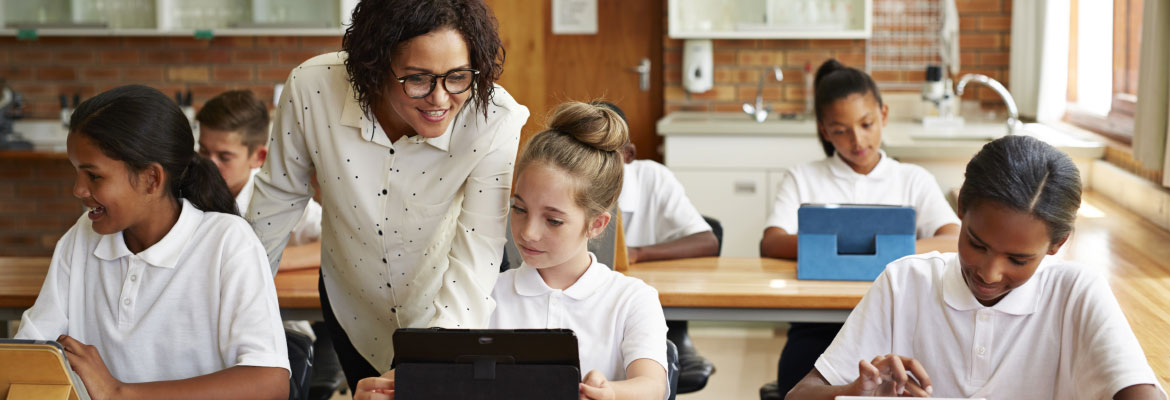4 January 2022
The opportunities for education technology in the digital age
By Simon Carter, Marketing Director, RM

Education is constantly evolving – as is the role that technology plays within it. From traditional chalkboards to connected whiteboards to online homework and collaboration in virtual breakout rooms, students and teachers are always looking at new approaches and techniques to enhance the environment and make learning a more enriching experience.
In more recent times, students have adapted to significant changes in the way their education system works – with the pandemic undoubtedly the catalyst for the most seismic of shifts in schools. Whilst that change had already started, as schools were forced to close to all but the vulnerable, teaching was simply no longer possible in the classroom, lecture halls became dark and collaboration in person was put on hold for some time.
But all was not lost, as technology came into its own with computers – and the way they were used – becoming critical in maintaining education standards. Lectures and lessons started to take place on computer screens and the old-fashioned idea of what classroom learning looked like started to change.
Microsoft Teams, Google Classroom and Zoom became a teacher’s best friend. Though at first this seemed isolating, there were major benefits that came from it which were quickly embraced by everyone. For many, they moved further forward with technology in five weeks than seemed possible in five years, before the pandemic hit. They accelerated the shift to digital in schools and paved the way for new systems and technologies that revolutionised the way students learnt and how they were assessed.
A case of trial and error for maximum engagement
Change is hard. Figuring out the best initiatives and technologies for schools was always going to be a tricky task.
Ultimately, any piece of technology – from an overhead projector to a virtual reality (VR) headset – is only effective if it is successful in keeping students engaged in learning and where the users have the knowledge to get the most from it – a new shiny toy is just that, unless the teacher has been trained in how to introduce it into the curriculum.
One of the biggest headaches for headteachers is recruiting and retaining teachers during a period where everyone is struggling with increased workloads. But that is where this new technology can play a part. The majority of headteachers (74%) and teachers (65%) believe that technology already had – or would in the future – contribute to reduced workloads. But again, that doesn’t happen without effort. Schools must have an IT strategy in place to aid teachers in increasing their accomplishments day to day whilst freeing them up to have a deeper relationship with their student. This ultimately reduces the time they spend preparing for lessons and marking assignments – the two biggest causes of excessive workload.
This alignment between a school business strategy and IT strategy is critical. Whilst technology has the potential to add real value, for those that do it poorly, it can end up being a weight around your neck.
From connected whiteboards to a connected world
Modern digital software and hardware allows peers to collaborate seamlessly even when they may not be there in person. It can be accessed at anytime from anywhere when it is needed, and can be extended in so many ways – for example, gone are the “curly sandwiches”? at parents evenings as schools realise they can engage with parents in a much more constructive and effortlessly way, over a remote online connection. Behind the scenes, as schools dispense with large and expensive on-site servers – replacing them with cloud technology – schools become not only more efficient, but also reduce costs by not needing specialist IT teams. It also means enhanced protection and security with less risk of cyber-attacks. 70% of UK schools said it cut costs and 59% felt it enabled them to manage systems more efficiently than previous systems.
The opportunities are significant, but most schools will admit that they are not technology experts – they are teachers. This is where it can help to talk to people who have worked with thousands of schools – up and down the country (and globally). RM is one such company that has been supporting schools for almost 50 years, and because they only work in education, are passionate about providing the correct tools for each school on a case-by-case basis.
The future of education technology
The future of education technology is exciting, with many schools investing time into aligning their IT strategies with the needs of modern learning and what suits their pupils best – looking at how being digital can enhance almost everything that they do.
So where next? The opportunities are endless, but one area that is being talked about more and more, is the role of digital assessment. As schools look for more authentic forms of assessment, in ways that free up time so that teachers focus their effort on intervening where it is most needed, the days of vast school halls with students handwriting essays whilst invigilators march up and down alongside them, seem to be on their way out.
This is an exciting space, with the lockdown period helping many teachers and school staff overcome their fears of digital. With this newfound confidence – coupled with a level of IT investment that few could have predicted just a year before – now is the time to embrace what we have and take a giant leap forward. We must continually be on the lookout for gaps in the current education system – identifying how technology can improve and enhance experiences, leading to greater outcomes for all – both now and in the future.